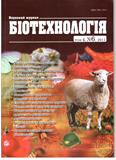ISSN 1995-5537

"Biotechnology" journal V. 4, No. 6, 2011
Р. 31-35, Bibliography 14, Ukrainian.
Universal Decimal classification: 577.151:544.023.223
PHENOL OXIDATION USING COVALENTLY IMMOBILIZED HORSERADISH PEROXIDASE
I. I. Romanovska,O. V. Oseychuk,S. S. Dekina, Y. A. Shesterenko,
O. V. Sevastyanov, T. Yu. Gromovoy
Bogatsky’s Physico-Chemical Institute of National Academy of Sciences of Ukraine, Odesa
Chuiko Institute of Surface Chemistry of National Academy of Sciences of Ukraine, Kyiv
Odesa National Medical University
According to modified Bakh’s method, partially purified horseradish peroxidase preparation (RZ = 1,0; activity 100 U/mg of protein) was isolated. Molecular mass of obtained HPR (42 972 Da) was confirmed by mass-spectrometry: matrix activated laser desorption/ ionization. The enzyme was covalently immobilized by periodate oxidation of polysaccharide membrane «Diacell», followed by sodium borohydride reduction, at mass ratio enzyme: support 0.2:1. The biocatalyst with quantitative protein coupling, 88% of activity’s pH- and thermooptima, increased termostability, stable at storage (8 months) was obtained. Kinetic studies had shown the increasing of hydrogen peroxide and pyrogallol Kм values and decreasing of Vmax values during immobilized HPR-catalyzed reactions. In the batch reactor the biocatalyst developed promoted the quantitative phenol oxidation (1 mmol/dm3) during 7 cycles of usage and high level of it’s bioconversion (95–50%) during the next 15 cycles. Molecular weight (about 2021 Da) of polymer product, insoluble in water and most organic solvent, of peroxidase oxidation of phenol — polioxyfenilene (particle size is from 15 to 75 mm) consisting of 21 units was first determined by laser desorption/ionization.
Key words: horseradish peroxidase, Diacell membrane, covalent immobilization, phenol oxidation, polyhydroxyphenylene.
© Palladin Institute of Biochemistry of National Academy of Sciences of Ukraine, 2008

